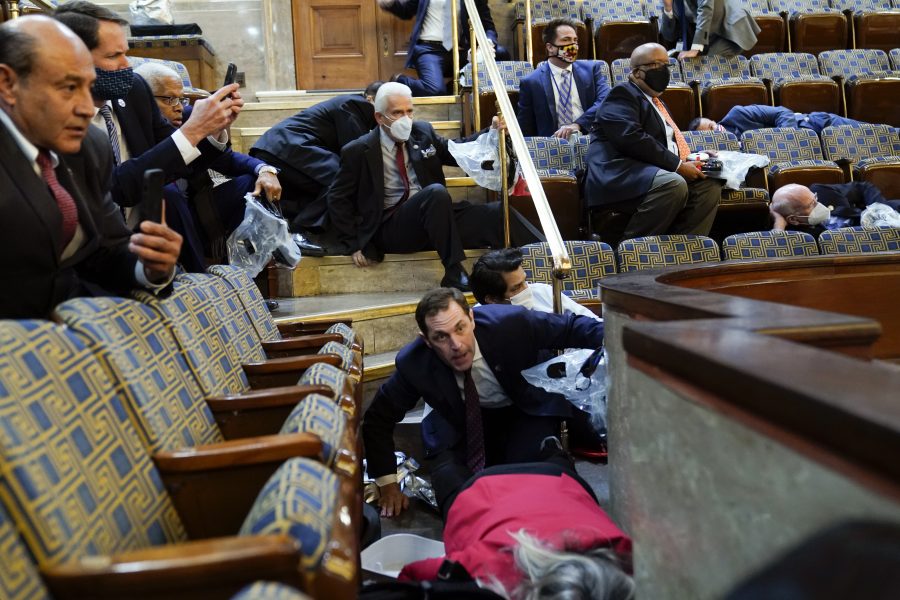The entire District of Columbia National Guard, along with Guard personnel from Virginia, were activated Jan. 6 after a mob stormed the U.S. Capitol building, with more violence expected across Washington, D.C., throughout the night. The same day, Maryland Gov. Larry Hogan announced a mobilization of 500 members of the Maryland National Guard “to help restore law and order” within the district, and New Jersey Gov. Phil Murphy offered New Jersey National Guard support, as needed.
Acting Defense Secretary Christopher C. Miller and Chairman of the Joint Chiefs of Staff Gen. Mark A. Milley spoke with Vice President Michael R. Pence, Speaker of the House Nancy Pelosi, Senate Majority Leader Mitch McConnell (R-Ky.), Sen. Chuck Schumer (D-N.Y.), and Rep. Steny Hoyer (D-Md.), after President Donald J. Trump’s supporters stormed the Capitol building. Miller’s statement did not mention any discussions with the President before the entire D.C. National Guard was activated.
“We are prepared to provide additional support as necessary and appropriate as requested by local authorities,” Miller said. “Our people are sworn to defend the constitution and our democratic form of government and they will act accordingly.”
D.C. Mayor Muriel Bowser initially requested about 340 National Guardsmen to help police prepare for the protests. Following the breach of the Capitol, the U.S. Capitol Police on Jan. 6 requested additional Guard support, which was approved, Army Secretary Ryan D. McCarthy told reporters during a joint press briefing with Bowser and the head of the Metropolitan Police Department.
“Around three o’clock this afternoon, we mobilized the D.C. National Guard for 100-percent strength,” he said. “We’ll have 1,100 personnel that are convening at the Armory as we speak to support [the] Metro P.D. in reestablishing the safety at the confines of the U.S. Capitol. We’ll also be working with other federal law enforcement entities that are gonna be coming here, the Metropolitan Police Station, and add support capability as they continue deliberate planning and looking at how a clearing operation can be conducted.”
McCarthy admitted that “a lot of questions were asked” and that “a little bit of confusion” ensued while the request was deliberated. However, he said the decision to mobilize the whole DCNG was made within about 30 minutes’ time.
“This has been incredibly fluid, but I have to go through the Secretary of Defense to ultimately get the final approval to mobilize personnel, as well as to conduct operations in cooperation [and] coordination with local authorities,” he noted.
McCarthy didn’t indicate whether a deployment of Virginia National Guard troops to D.C. announced by Virginia Governor Ralph S. Northam in a Jan. 6 tweet was part of Bowser’s initial troop request or the subsequent one from the U.S. Capitol Police Department, how many VANG troops were activated, or whether Guard support from other states—in the form of troops or other assets—might be incoming.
Bowser also ordered a district-wide curfew that took effect at 6 p.m. EST on Jan. 6 and is slated to lift at 6 a.m. EST on Jan. 7.
“During the hours of the curfew, no person, other than persons designated by the Mayor, shall walk, bike, run, loiter, stand, or motor by car or other mode of transport upon any street, alley, park, or other public place within the District,” she wrote.
An undisclosed number of Airmen from the District of Columbia Air National Guard’s 113th Wing were among the initial batch of approximately 340 DCNG personnel backing up law enforcement and emergency responders in the District, a DCNG spokesperson confirmed in a Jan. 6 email to Air Force Magazine.
“The D.C. Guard has been mobilized to provide support to federal law enforcement in the District,” Pentagon spokesman Jonathan Rath Hoffman said in a statement. “Acting Secretary Miller has been in contact with Congressional leadership, and [Army] Secretary [Ryan D.] McCarthy has been working with the D.C. government. The law enforcement response will be led by the Department of Justice.”
Bowser and D.C. Homeland Security and Emergency Management Director Christopher Rodriguez asked for the backup, and McCarthy greenlit it, DCNG wrote. The activation was slated to last through Jan. 7.
DCNG said the troops’ taskings were slated to include:
- Controlling crowds at Metro stations
- Helping police close down streets at intersections to help keep pedestrian areas safe
- Civil Support Team backup to D.C. Fire and Emergency Management Services
“Guardsmen are prepared to respond to augment the main missions, should additional personnel be required,” the release added at the time.
On the morning of Jan. 6, DCNG spokesperson Capt. Tinashe T. Machona told Air Force Magazine that none of its aviation assets would be used during the mission, and he previously told Task & Purpose that D.C. Guard personnel would be unarmed.
DCNG troops taking part in the response are also donning black vests to transparently identify themselves as U.S. troops, the DCNG release stated.
“The black identification vest is not body armor nor a tactical vest,” the release explained. “It is the traditional uniform worn by the D.C. National Guard members in multiple domestic operations including Presidential Inaugurations, the COVID-19 pandemic response, the 4th of July celebration and the ‘Anniversary March on Washington’ in the last year.”
